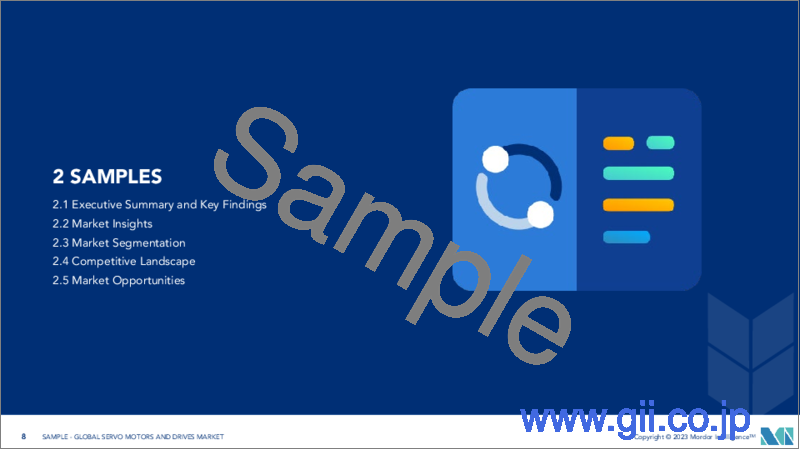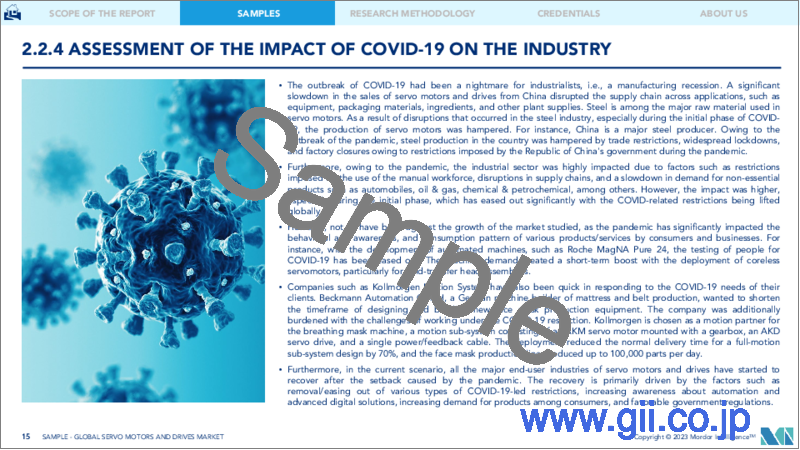|
|
市場調査レポート
商品コード
1198312
サーボモーターおよびドライブ市場- 成長、動向、予測(2023年-2028年)Servo Motors and Drives Market - Growth, Trends, and Forecasts (2023 - 2028) |
||||||
|
● お客様のご希望に応じて、既存データの加工や未掲載情報(例:国別セグメント)の追加などの対応が可能です。 詳細はお問い合わせください。 |
|||||||
| サーボモーターおよびドライブ市場- 成長、動向、予測(2023年-2028年) |
|
出版日: 2023年01月23日
発行: Mordor Intelligence
ページ情報: 英文 120 Pages
納期: 2~3営業日
|
- 全表示
- 概要
- 目次
サーボモーターおよびドライブの市場は、予測期間中に5.7%のCAGRで推移すると予想されています。
最近の技術的進歩や、いくつかの国における最小エネルギー性能基準(MEPS)などの政府政策の実施により、エネルギー効率の高いモーターシステムが生まれ、サーボモーターを後押しし、市場を牽引しているのです。
主なハイライト
- 工作機械における操作の柔軟性は、最も大きな利点の1つです。さらに、サーボは従来のギア、ベルト、プーリーに代わるもので、旧来の技術にありがちな摩耗や故障の問題を解消します。サーボは、生産性、信頼性、および機械スループットを向上させます。高いピークトルク、高い加速度、可能な限り小さな物理的パッケージは、調査した市場全体で開発する上で重要な考慮事項です。さらに、サーボモータは、コンピュータのセンサーやコントローラからの入力を受け取るために特別に装備されており、CNC機械加工、ロボット工学、高度な自動製造などの精密な動作の実行に適しています。
- 既存および新興諸国におけるデジタル化の実現に向けた政府の関与の高まりや、建物開発への投資の増加は、ビジネス環境をさらに向上させるでしょう。また、モータシステムの高速・高精度動作に対する産業界の要望が高まることで、サーボモータやアンプの使用も増加すると考えられます。さらに、技術の進歩に加え、運用更新の強化に焦点を当てた規制上の税還付政策が、市場の拡大を後押しするものと思われます。
- エネルギー効率の高い国際規格の採用、オートメーション技術の進歩、モーター制御部品のモーターへの搭載が、業界の拡大を後押ししています。エネルギー効率の高い国際規格の採用、自動化技術の進展、モーター制御部品のモーターへの搭載が進み、サーボモーターおよびドライブの市場は牽引力を増しています。サーボモーターおよびドライブは、高精度、高速、小型化など、さまざまなメリットをもたらします。さらに、自動化が進むにつれて、サーボモーターおよびドライブはさまざまな分野のさまざまなアプリケーションで使用されるようになってきています。
- このような促進要因と利点がある一方で、サーボモーターおよびドライブの市場はいくつかの制限要因と課題によって制約を受ける可能性があります。代替製品の存在は、サーボモータとドライブ市場の成長に対する主要な課題です。さらに、サーボモーターおよびドライブに関連する高い価格と、サーボ技術を採用するために必要な初期投資が、市場の開拓を制限する可能性があります。
- COVID-19の発生は、産業界にとって製造業不況の前触れとなっています。中国からのサーボモーターやドライブの販売が大幅に減速し、装置、包装材、原料、その他の工場用品など、用途を超えたサプライチェーンが混乱しました。ロシュ・マグナ・ピュア24などの自動機の開発により、COVID-19の人体検査は緩和されました。機械需要は、特に流体移送ヘッドアセンブリにコアレスサーボモータを配備し、短期的に盛り上がりを見せた。パンデミック後、製造装置が再開され、サーボモーターの需要が増加しました。
サーボモーターおよびドライブの市場動向
新興国における急速な工業化が市場の成長を牽引
- 近年、工業プロセスの自動化により、生産量の増加、コスト削減、高精度化、労働力の削減が進んでいます。同様に、オートメーション分野も急速に拡大しており、最新の計測器や機械がさまざまな用途に利用されています。
- 多くの企業が業務の簡素化と生産量全体の向上のために、従来のモーターをサーボモーターやドライブに置き換え続けており、急速に発展するインダストリー4.0の流れは、市場参入企業に多くの機会をもたらしています。
- 多くの企業は、入力信号によって制御される精密な動作を行うために、サーボモーターやドライブに切り替えています。これは、マルチコアサーボモータ・ドライブが、精度の向上、フィードバックの改善、制御性の向上を実現するため、インダストリー4.0の重要な基盤として浮上してきたことと一致します。安川電機は昨年3月、ACサーボドライブ「HO-Xシリーズ」の発売を発表しました。この製品は、半導体・液晶製造装置、電子部品実装機、工作機械、金属加工機、包装機、産業用ロボット、その他一般産業機械など、さまざまな用途で使用されています。
- 新興国を中心に先端技術の活用や自動化に取り組む製造業が増加しており、産業用ロボットの需要もかつてないほど高まっています。自動車、電気・電子、自動車、金属、その他の機械加工分野における幅広い組立、ピックアップ、製造用途で産業用ロボットの使用が増加していることが、複数の業種におけるサーボモーターおよびドライブの展開に拍車をかけています。
- IFRによると、中国では昨年、約16万8,000台の産業用ロボットが新たに設置され、世界的に最大規模のロボット設置台数が設定されました。しかし、この国は輸入技術に依存していました。2年前、中国の産業用ロボット設置台数の70%以上が外国メーカーによるものでした。したがって、新興国の急速な工業化、自動化とロボットの採用の増加は、予測期間にわたってサーボモータおよびドライブ市場を駆動すると予想されます。
北米が最大の市場規模を記録する見込み
- この地域では、複数の製造工程の自動化が進んでおり、精度と再現性が要求されるため、サーボモータが使用されています。油圧ポンプや誘導モーターとは異なり、サーボモーターは稼働中にオン・オフを繰り返すため、電力消費が抑えられます(最大65%の節約)。
- また、ブラシレス設計のため、飲食品、防衛、海底・石油・ガスなどの過酷な用途に使用されています。
- 供給面では、応用モーション製品がMDX一体型サーボモータの受け入れを拡大させました。この認証により、米国のユーザーは、このモーターが電気安全に関する高品質な規格を満たしていることを保証されます。統合型モータは、ANSI/UL規格1004-1 Rotating Electrical Machines, 1004-6 Servo and Stepper Motors, and 61800-5-1 Adjustable Speed Drivesに準拠して評価されています。この認証は、ULファイル番号E472271の下に記載されています。
- 米国の長期的な再生可能エネルギーの成長が、サーボモーター調達の伸びを牽引すると期待されています。サーボモータは、太陽エネルギーを利用するためにソーラーパネルの角度を調整し、風力タービンを風向きに向けるため、これらの部品はこの分野の成功に欠かせないものとなっています。
- また、風力発電や太陽光発電の開発企業は、米国の連邦税制優遇措置を利用するために、プロジェクトを急速に完成させています。企業の電力購入契約(PPA)や州レベルの政策が、同国での迅速なプロジェクト完了の大きな推進力となっています。また、IEAは、北米における分散型太陽光発電の拡大が、2019年から2024年にかけて、主に米国が牽引して、2013年から2018年に比べて2倍急速に進むと予測されていると報告しています。
その他の特典
- エクセル形式の市場予測(ME)シート
- 3ヶ月間のアナリストサポート
目次
第1章 イントロダクション
- 調査の前提条件と市場の定義
- 調査対象範囲
第2章 調査手法
第3章 エグゼクティブサマリー
第4章 マーケットインサイト
- 市場概要
- 産業の魅力- ポーターのファイブフォース
- 新規参入業者の脅威
- 買い手/消費者の交渉力
- 供給企業の交渉力
- 代替品の脅威
- 競争企業間の敵対関係
- 産業バリューチェーン分析
- COVID-19が市場に与える影響
第5章 市場力学
- 市場促進要因
- 新興国における急速な工業化
- エネルギー効率に関する規制の拡大
- 市場の課題
- 代替製品の存在
第6章 市場セグメンテーション
- タイプ
- モーター
- ACサーボモーター
- DCブラシレスサーボモーター
- ブラシ付DCサーボモーター
- リニアサーボモータ
- ドライブ
- ACサーボドライブ
- DCサーボドライブ
- アジャスタブルサーボドライブ
- その他のドライブ
- モーター
- 電圧範囲
- 低電圧
- 中電圧
- エンドユーザー産業
- 自動車
- 石油・ガス
- ヘルスケア
- パッケージング
- 半導体・エレクトロニクス
- 化学・石油化学
- その他のエンドユーザー産業
- 地域別
- 北米
- 米国
- カナダ
- 欧州
- ドイツ
- 英国
- フランス
- その他の欧州地域
- アジア太平洋地域
- 中国
- 日本
- インド
- 韓国
- その他アジア太平洋地域
- ラテンアメリカ
- 中東地域
- 北米
第7章 競合情勢
- 企業プロファイル
- Yaskawa Electric Corp.
- Mitsubishi Electric Corp.
- Siemens AG
- Schneider Electric
- Rockwell Automation, Inc.
- ABB Ltd
- Delta Electronics, Inc.
- FANUC Corp.
- Kollmorgen Corp.
- Bosch Rexroth AG
第8章 投資分析
第9章 市場の将来性
The servo motors and drives market is anticipated to register a CAGR of 5.7 % during the forecast period. The recent technological advancements and implementation of government policies, like Minimum Energy Performance Standards (MEPS), in several countries gave rise to energy-efficient motor systems, boosting the servo motor and driving the market.
Key Highlights
- Flexibility in machine tool operations is one of the most significant benefits. Additionally, servos replace traditional gears, belts, and pulleys to eliminate wear and failure problems, typical with older technologies. Servos increase productivity, reliability, and machine throughput. High peak torque, high acceleration, and the smallest physical package possible are critical considerations to developments across the market studied. Moreover, servo motors are specially equipped to take inputs from computer sensors and controllers, making them fit for executing precise activities, such as CNC machining, robotics, and advanced automated manufacturing.
- Rising government involvement in achieving digitization across established and emerging countries and increased investment in building development will further enhance the business environment. The growing industrial desire for high-speed and precision motor system operation will increase the use of servo motors and amplifiers. Furthermore, technological progress, along with regulatory tax rebate policies focused on reinforcing operational updates, is expected to boost market expansion.
- The adoption of energy-efficient international standards, the advancement of automation technology, and the inclusion of motor control components in motors are driving the expansion of the industry. With the increasing acceptance of energy-efficient international standards, the development of automation technologies, and the inclusion of motor control components in motors, the servo motors and drives market is gaining traction. Servo motors and drives provide various benefits, including high precision, speed, and size reduction. Furthermore, as automation advances, servo motors and drives are finding usage in various applications across various sectors.
- With all of the drivers and benefits, the market for servo motors and drives may be constrained by some limitations and challenges. The Presence of Substitute Products is a key challenge to the growth of the servo motors and drives market. Furthermore, the high prices associated with servo motors and drives and the initial investment required to adopt servo technology may limit market development.
- The outbreak of COVID-19 has been a harbinger for industrialists, i.e., a manufacturing recession. A significant slowdown in the sales of servo motors and drives from China disrupted the supply chain across applications, such as equipment, packaging materials, ingredients, and other plant supplies. With the development of automated machines, such as Roche MagNA Pure 24, the testing of people for COVID-19 has been eased out. The machine demand created a short-term boost with the deployment of coreless servomotors, particularly for fluid-transfer head assemblies. After the pandemic, manufacturing units resumed, and demand for servo motors increased.
Servo Motors & Drives Market Trends
Rapid Industrialisation Across the Emerging Economies Drives the Market Growth
- In recent years, automation in industrial processes has resulted in increased output, lower costs, greater precision, and fewer labor requirements. Similarly, the automation sector is expanding rapidly, resulting in various applications for modern instruments and machinery.
- With a huge number of businesses continuing to replace traditional motors with servo motors and drives to simplify operations and improve overall output, the rapidly developing trend of industry 4.0 has produced a stream of opportunities for market participants.
- Many businesses have switched to servo motors and drives to perform precise operations controlled by input signals. This is consistent with the fact that because multicore servo motors and drives offer improved accuracy, better feedback, and more control, they have emerged as a critical basis for Industry 4.0. In March last year, Yaskawa Electric Corporation announced the launch of the AC servo drives Σ-X Series. It is used in various applications like Semiconductor and LCD manufacturing equipment, Electronic component mounting machines, Machine tools, Metal processing machines, Packaging machines, -Industrial robots, and Other general industrial machinery.
- With increasing manufacturing companies focusing on utilizing advanced technologies and adopting automation in various developing nations, the demand for industrial robots remains unprecedented. The increasing usage of industrial robots in a wide range of assembly, pick-up, and manufacturing applications across the automotive, electrical/electronics, automotive, metal, and other machining sectors is fueling the deployment of servo motors and drives across several verticals.
- According to IFR, approximately 168 thousand new industrial robot installations in China had set up the maximum robotics globally in the last year. However, the country was dependent on imported technology. Early two years, over 70 percent of Chinese industrial robot installations came from foreign manufacturers. Therefore, rapid industrialization across emerging economies and such increased adoption of automation and robotics is anticipated to drive the market for servo motors and drives over the forecast period.
North America is Expected to Register the Largest Market
- With multiple manufacturing processes in the region becoming increasingly automated, demanding accuracy and needing repeatability are being served by servo motors. Unlike hydraulic pumps or induction motors, which remain in use, the servo motors are switched on and off during their operation for less power usage (saving up to 65%).
- Due to their brushless design, these servo motors have catered to applications across harsh and demanding sectors, such as food and beverage applications, defense applications, and subsea and oil and gas applications.
- On the supplier front, applied motion products increased the acceptance of MDX Integrated servo motors. The certification assures users in the United States that the motors meet high-quality standards for electrical safety. Integrated motors are evaluated according to ANSI/UL standards 1004-1 Rotating Electrical Machines, 1004-6 Servo and Stepper Motors, and 61800-5-1 Adjustable Speed Drives. The certifications are noted under the UL file number E472271.
- Long-term renewable energy growth for the United States is expected to drive the growth in servo motor sourcing. As servo motors adjust the angle of solar panels to harness solar energy and point wind turbines in the direction of the wind, these components are critical to the sector's success.
- Also, wind and solar PV developers have been completing projects rapidly to avail of federal tax incentives in the United States. The corporate power purchase agreements (PPAs) and state-level policies are significant drivers to speedy project completion in the country. The IEA also reported that an expansion of distributed solar PV in North America had been forecasted as twice as rapid between 2019 and 2024 compared to 2013 and 2018, mainly driven by the United States.
Servo Motors & Drives Market Competitor Analysis
The Servo Motors and Drives Market is highly fragmented due to the presence of major players like Yaskawa Electric Corp., Mitsubishi Electric Corp., Siemens AG, Schneider Electric, and Rockwell Automation, Inc. Players in the market are adopting strategies such as partnerships and acquisitions to enhance their product offerings and gain sustainable competitive advantage.
In January 2022, Mitsubishi Electric Automation, Inc. announced the availability of the MELSERVO-J5D common DC bus servo drive system. MELSERVO-J5D servo amplifiers are appropriate for medium to large servo applications requiring several drive units with regenerative energy management. MELSERVO-J5D servo amplifiers, available in 400V and 1kW to 7kW capacities, extend the MELSERVO-J5 portfolio's existing driving capabilities and are compatible with MELSERVO-J5 servo motors (HK-KT/ST/RT/MT).
Additional Benefits:
- The market estimate (ME) sheet in Excel format
- 3 months of analyst support
TABLE OF CONTENTS
1 INTRODUCTION
- 1.1 Study Assumptions and Market Definition
- 1.2 Scope of the Study
2 RESEARCH METHODOLOGY
3 EXECUTIVE SUMMARY
4 MARKET INSIGHTS
- 4.1 Market Overview
- 4.2 Industry Attractiveness - Porters Five Forces
- 4.2.1 Threat of New Entrants
- 4.2.2 Bargaining Power of Buyers/Consumers
- 4.2.3 Bargaining Power of Suppliers
- 4.2.4 Threat of Substitute Products
- 4.2.5 Intensity of Competitive Rivalry
- 4.3 Industry Value Chain Analysis
- 4.4 Impact of COVID-19 on the Market
5 MARKET DYNAMICS
- 5.1 Market Drivers
- 5.1.1 Rapid Industrialisation Across the Emerging Economies
- 5.1.2 Growing Regulations Regarding Energy Efficiency
- 5.2 Market Challenges
- 5.2.1 Presence of Substitute Products
6 MARKET SEGMENTATION
- 6.1 Type
- 6.1.1 Motor
- 6.1.1.1 AC Servo Motor
- 6.1.1.2 DC Brush Less Servo Motor
- 6.1.1.3 Brushed DC Servo Motor
- 6.1.1.4 Linear Servo Motor
- 6.1.2 Drive
- 6.1.2.1 AC Servo Drive
- 6.1.2.2 DC Servo Drive
- 6.1.2.3 Adjustable Servo Drive
- 6.1.2.4 Other Types of Drives
- 6.1.1 Motor
- 6.2 Voltage Range
- 6.2.1 Low-voltage
- 6.2.2 Medium voltage
- 6.3 End User Industry
- 6.3.1 Automotive
- 6.3.2 Oil and Gas
- 6.3.3 Healthcare
- 6.3.4 Packaging
- 6.3.5 Semiconductor and Electronics
- 6.3.6 Chemicals and Petrochemicals
- 6.3.7 Other End User Industries
- 6.4 Geography
- 6.4.1 North America
- 6.4.1.1 United States
- 6.4.1.2 Canada
- 6.4.2 Europe
- 6.4.2.1 Germany
- 6.4.2.2 United Kingdom
- 6.4.2.3 France
- 6.4.2.4 Rest of Europe
- 6.4.3 Asia Pacific
- 6.4.3.1 China
- 6.4.3.2 Japan
- 6.4.3.3 India
- 6.4.3.4 South Korea
- 6.4.3.5 Rest of Asia Pacific
- 6.4.4 Latin America
- 6.4.5 Middle East
- 6.4.1 North America
7 COMPETITIVE LANDSCAPE
- 7.1 Company Profiles*
- 7.1.1 Yaskawa Electric Corp.
- 7.1.2 Mitsubishi Electric Corp.
- 7.1.3 Siemens AG
- 7.1.4 Schneider Electric
- 7.1.5 Rockwell Automation, Inc.
- 7.1.6 ABB Ltd
- 7.1.7 Delta Electronics, Inc.
- 7.1.8 FANUC Corp.
- 7.1.9 Kollmorgen Corp.
- 7.1.10 Bosch Rexroth AG




